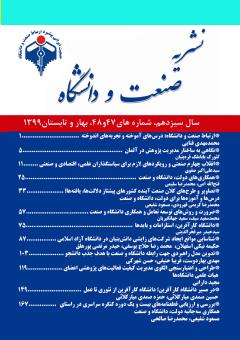تدوین مدل راهبردی جهت رابطه دانشگاه و"صنعت" با هدف جذب دانشجو
محورهای موضوعی : عمومى
مهدی بهاردوست
1
![]() ,
فریبا حنیفی
2
,
حسن شهرکی پور
3
,
فریبا حنیفی
2
,
حسن شهرکی پور
3
1 - استادیار، دانشکده مدیریت، دانشگاه آزاد اسلامی واحد هادیشهر، آذربایجان شرقی، ایران
2 - استادیار، دانشکده علوم تربیتی، دانشگاه آزاد اسلامی واحد رودهن، تهران، ایران
3 - دانشیار، دانشکده علوم تربیتی، دانشگاه آزاد اسلامی واحد رودهن، تهران، ایران
کلید واژه: سیاست های جذب دانشجو, دانشگاه, صنعت,
چکیده مقاله :
هدف اين مقاله تدوین مدل راهبردی جهت رابطه دانشگاه و"صنعت" با هدف جذب دانشجو می باشد. روش پژوهش آمیخته از نوع اکتشافی بود. جامعه آماری در بخش کیفی شامل سه 20 نفر از سه گروه 1) خبرگان صنعتی؛ بهعنوان نمایندۀ بخش صنعت؛ 2) مدیران و کارشناسان وزارت صنعت، بهعنوان نمایندۀ بخش دولتی و سیاستگذاری؛ 3) روسای دانشگاهها و معاونین واحدهای دانشگاهی و اعضای شورای برنامه ریزی دانشگاه های آزاد،اعضای شورای عالی انقلاب فرهنگی که دارای تجارب و اطلاعات غنیتری در زمینۀ ارتباط دانشگاه با صنعت هستند..رويکرد نمونه گیری، هدفمند و روش نمونه گیری صاحبنظران کلیدی بود. ابزار پژوهش، مصاحبه عمیق نیمه ساخت مند بود. دربخش کیفی و در قسمت اول، استخراج داده ها و مولفه ها با روش کد گذاری وروش داده بنیاد می باشدسپس جهت ساخت مدل پژوهش از مصاحبه با خبرگان و پرسشنامه استفاده شده است. الگوی مستخرج از تجزیه وتحلیل یافته های پژوهش در قالب هفت بعد اصلی، و سی پنج معیار طراحی شد. هفت بعد اصلی عبارت اند از:« عوامل داخل و درون دانشگاهی »« عوامل خارج و برون دانشگاهی »«سیاست گذاری وطراحی مجدد»« ارتقاء آکادمیک»«بسترهای قانونی»«تحولات اساسی»«نهادینه کردن »در بخش کمی روش تحقیق توصیفی - پیمايشی بودو جامعه آماری شامل31 نفر شامل اساتید دانشگاه آزاد، روسای دانشگاه آزاد و فعالین حوزه صنعت، مدیریت و مسائل جذب دانشجوكه طبق احكام كارگزيني رسمي آزمايشي، قراردادي، رسمي قطعي در بخشهاي مختلف اين سازمان در سال تحصیلی 1399-1398 اشتغال داشتهاندکه برای اعتباريابی الگو، با استفاده از رويکرد نمونه گیری هدفمند و روش صاحبنظران کلیدی، انتخاب شدند. ابزار مورد استفاده در بخش کمی، پرسشنامه محقق ساخته بر اساس شبکه مضامین بخش کیفی بود.
The purpose of this article is to develop a strategic model for the relationship between university and "industry" with the aim of attracting students.The research method was heuristic. The statistical population in the qualitative section includes three20people from three groups1) industrial experts; As a representative of the industry sector;2)Managers and experts of the Ministry of Industry, as representatives of the public sector and policy-making;3)Heads of universities and vice chancellors and members of the Planning Council of Free Universities, members of the Supreme Council of the Cultural Revolution who have richer experiences and information in the field of university-industry relations.The sampling approach was purposeful and the sampling method was key experts.The research tool was a semi-structured in-depth interview.In the qualitative part and in the first part,the extraction of data and components is based on the coding method and data method of the foundation.Then,interviews with experts and a questionnaire have been used to construct the research model.The model extracted from the analysis of research findings was designed in the form of seven main dimensions,and thirty-five criteria.The seven main dimensions are:"internal and external factors","external and external factors","policy-making and redesign","academic promotion","legal contexts","fundamental changes","institutionalization"in the quantitative part of the descriptive research method-Budo survey The statistical population includes31people including Azad University professors,Azad University presidents and activists in the field of industry,management and student recruitment issues who have been employed in different parts of the organization in the academic year 1398-1399 in accordance with the rules of formal,contract,and formal recruitment.The model was selected using purposive sampling approach and the method of key experts.The instrument used in the quantitative section was a researcher-made questionnaire based on the qualitative section content network.
حسینی، حسن و فرهادینهاد، رومینا (1394). شناسایی مقیاسهای سنجش تصویر ذهنی از برند در دانشگاه. فصلنامه اندازهگیری تربیتی، (8)3، 109-132.
ذاکر صالحی ،غلامرضا وطالحی نجف آبادی ،مایده(1395)."ارائه راهبردهایی برای جذب دانشجویان خارجی در ایران"موسسه پژوهش و برنامه ریزی آموزش عالی.
غلامی ،زهرا و آراسته حمیدرضا (1397) ، طراحی الگوی کارکرد پژوهشی دانشگاهها با رویکرد صنعت یاری،فصلنامه مطالعات راهبردی سیاستگذاری عمومی ، مقاله 11، دوره 8، شماره 27، تابستان 1397، صفحه 231-253
میرغفوری، سید حبیباله؛ شعبانی، اکرم؛ محمدی، خدیجه و منصوری محمدآبادی، سلیمان (1395). شناسایی و رتبهبندی عوامل مؤثر بر بهبود کیفیت خدمات آموزشی با استفاده از رویکرد تلفیقی ویکور فازی و مدلسازی ساختاری تفسیری. فصلنامه آموزش و ارزشیابی، (34)-9 .
Gill, S.(2016) Overseas Students' Intercultural Adaptation as Intercultural Learning: A Transformative Framework. Compare: A Journal of Comparative and International Education 37(2): 167–183.
Thurik, A.R.(2009) Entrepreneurship, economic growth and policy in emerging economies, UNU -WIDER Research Paper RP2009/12, United Nations University and World Institute for Development Economics Research, Helsinki, March.
Parshakov, P., Parshakov, P., Shakina, E. A., & Shakina, E. A. 2018. “With or without CU: a comparative study of efficiency of European and Russian corporate universities”. Journal of Intellectual Capital. Vol. 19(1). Pp. 96-111.
Leal Filho, W., Morgan, E. A., Godoy, E. S., Azeiteiro, U. M., Bacelar-Nicolau, P., Ávila, L. V. & Hugé, J. (2017). “Implementing climate change research at universities: Barriers, potential and actions”. Journal of Cleaner Production. Vol. 170. Pp. 269-277.
Cricelli, L., Greco, M., Greco, M., Grimaldi, M., Grimaldi, M. & Llanes Dueñas, L. P. (2018). “Intellectual capital and university
performance in emerging countries: evidence from Colombian public universities”. Journal of Intellectual Capital. Vol. 19(1). Pp. 71-95.
Creswell, J. W., & Plano Clark, V. L. (2007). Designing and conducting mixed methods research.Thousand Oaks, CA: Sage Olsen, Deborah (2000) "Institutional Research". New Directions for IR, NO. 111, Jossey ـ Bass. A Wiley Company
. Terenzini, Patrick. (1999) "On the Nature of Institutional Research and Knowledge and Skills it Requires". New Directions for IR, NO. 104, US: Jossey ـ Bass, publishers.


